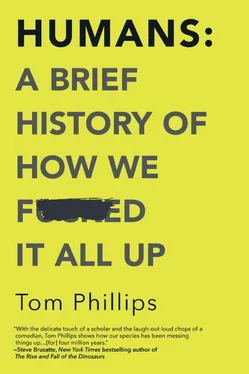Tom Phillips - Humans - A Brief History of How We F*cked It All Up
Здесь есть возможность читать онлайн «Tom Phillips - Humans - A Brief History of How We F*cked It All Up» весь текст электронной книги совершенно бесплатно (целиком полную версию без сокращений). В некоторых случаях можно слушать аудио, скачать через торрент в формате fb2 и присутствует краткое содержание. Город: Toronto, Год выпуска: 2019, ISBN: 2019, Издательство: Hanover Square Press, Жанр: История, Юмористические книги, на английском языке. Описание произведения, (предисловие) а так же отзывы посетителей доступны на портале библиотеки ЛибКат.
- Название:Humans: A Brief History of How We F*cked It All Up
- Автор:
- Издательство:Hanover Square Press
- Жанр:
- Год:2019
- Город:Toronto
- ISBN:978-1-48805-113-5
- Рейтинг книги:4 / 5. Голосов: 1
-
Избранное:Добавить в избранное
- Отзывы:
-
Ваша оценка:
- 80
- 1
- 2
- 3
- 4
- 5
Humans: A Brief History of How We F*cked It All Up: краткое содержание, описание и аннотация
Предлагаем к чтению аннотацию, описание, краткое содержание или предисловие (зависит от того, что написал сам автор книги «Humans: A Brief History of How We F*cked It All Up»). Если вы не нашли необходимую информацию о книге — напишите в комментариях, мы постараемся отыскать её.
Humans: A Brief History of How We F*cked It All Up — читать онлайн бесплатно полную книгу (весь текст) целиком
Ниже представлен текст книги, разбитый по страницам. Система сохранения места последней прочитанной страницы, позволяет с удобством читать онлайн бесплатно книгу «Humans: A Brief History of How We F*cked It All Up», без необходимости каждый раз заново искать на чём Вы остановились. Поставьте закладку, и сможете в любой момент перейти на страницу, на которой закончили чтение.
Интервал:
Закладка:
That must have been embarrassing for NASA, but maybe they were able to take comfort from the fact that they’re hardly alone in the field of scientific and technological cock-ups. Another example comes not from the space race, but an entirely different kind of race that scientists across the USA found themselves in when, in 1969, they were competing with their Soviet counterparts to uncover the mysteries of a revolutionary discovery: an entirely new form of water.
It was the height of the Cold War, and that all-consuming ideological showdown wasn’t just playing out in geopolitical maneuvers, nuclear brinksmanship and the shadowy world of espionage. It also birthed a contest between the communist and capitalist worlds to demonstrate their scientific and engineering prowess. New discoveries and technological breakthroughs were coming at a dizzying rate, and there was a constant terror of falling too far behind the enemy; in July that year, a human would walk on the surface of the moon, put there by the American government’s shocked reaction to a series of Soviet space-faring firsts.
Amid all these grand, cinematic breakthroughs, a novel form of water initially appeared to be little more than a minor wrinkle. First discovered in 1961 by Nikolai Fedyakin, a scientist working at a provincial Soviet laboratory far from the major centers of science, it wasn’t until his work was spotted by Boris Deryagin of the Institute for Physical Chemistry in Moscow that its potential importance was realized. Deryagin quickly replicated Fedyakin’s work and, unsurprisingly, gladly started taking credit for the discovery—but still, outside the Soviet Union, there was little interest. It was only when he presented his findings at a conference in England in 1966 that the international community sat up and began to take note. The race was on.
At first referred to as either “anomalous water” or “offspring water,” the discovery had remarkable properties. Fedyakin and Deryagin found that the process of condensing or forcing regular water through supernarrow, ultrapure quartz capillary tubes had somehow caused it to rearrange itself, radically altering its chemical properties. Anomalous water didn’t freeze at 0ºC; instead it froze at –40ºC. Its boiling point was even more extreme, at least 150ºC or possibly more, maybe as high as 650ºC. It was more viscous than water, barely a liquid at all, thicker and greasier—some descriptions said it resembled Vaseline. If you cut into it with a blade, the mark would remain.
First in England, and then in the USA, scientists set about replicating the Soviets’ work. It was a difficult process, as the capillaries necessary for the process also meant that only tiny amounts could be manufactured at a time: some laboratories couldn’t get the technique right at all, while others raced away, producing ever larger amounts of the anomalous water. It was from one of these labs in the US that the next big breakthrough came: enough anomalous water was synthesized that they were able to perform an infrared spectral analysis of the substance. Their results were published in the prestigious journal Science in June 1969, one month before Armstrong walked on the moon, and the paper sent the scramble for research into the substance into overdrive. Not only was it confirmation of the water’s radically different properties compared with standard water, it provided an explanation for it: the results suggested that this was a polymer version of water, the individual H2O molecules joining up in large chained lattices that made it more stable. And so “anomalous water” became known instead by the name we know it today: “polywater.”
The discovery of polywater “is sure to revolutionize chemistry,” wrote Popular Science in December of 1969, talking at length about its possible uses in cooling systems, as a lubricant for engines or as a moderator in nuclear reactors. It explained many aspects of the natural world: polywater was found in clay, explaining why clay retains its paste-like malleability until fired at superhigh temperatures sufficient to finally remove the polywater. Polywater might be responsible for aspects of the weather, small amounts of it seeding the formation of clouds. And it was certainly present in the human body.
The discovery would likely lead to a whole new branch of chemistry, as some labs reported that they had managed to produce polymer versions of other chemically vital liquids: polymethanol, polyacetone. Or, more sinister, there were concerns that it could have military applications, even be a weapon in its own right: its structure suggested that it existed at a lower energy state than normal water, raising the possibility that polywater coming into contact with ordinary water could potentially trigger a chain reaction, inducing the everyday water to rearrange itself, too, and adopt the polymer form. One drop of polywater added to a key strategic reservoir or river, it was theorized, had the potential to gradually convert the entire body of water, turning the whole thing into a syrup. The water supply of whole countries could be sabotaged.
In the wake of the Science paper, the US government stepped in. CIA agents debriefed researchers involved in its study, keen to ensure that all breakthroughs were kept in American hands. Polywater was nervously discussed across the media from the New York Times to small-town newspapers: Was the USA falling behind the Soviets? Polywater research was prioritized, and funding set aside. Hundreds of scientific papers were published on it in the year of 1970 alone. “Good news,” a relieved Wall Street Journal wrote in 1969, in the wake of the initial funding, “the US has apparently closed the polywater gap, and the Pentagon is bankrolling efforts to push this country’s polywater technology ahead of the Soviet Union’s.”
You’ve probably guessed by now, right? I mean, we’re quite a long way into this book; it should be fairly obvious at this point that the polywater story doesn’t end with a scientific triumph, everybody patting each other on the back and Nobels all around. But it wasn’t until the early 1970s, after years of research by the finest scientists in the very best laboratories across multiple continents, that the truth became apparent:
There’s no such thing as polywater. It simply doesn’t exist.
What Fedyakin and Deryagin had actually discovered, and what scientists across the world had spent years pursuing and faithfully replicating and studying every possible way, was a substance that’s more accurately described as “dirty water.” All of polywater’s allegedly miraculous properties turned out to simply be impurities that had crept into the supposedly sterile equipment.
One skeptical American scientist, Denis Rousseau, managed to replicate the spectral analysis of polywater almost perfectly with a few drops of his own sweat, squeezed out of his T-shirt following a handball match. That’s the mysterious substance the great powers of the Cold War era had been so desperately scrambling for control of. Sweat.
Awkward.
It’s not like there hadn’t been plenty of skeptical voices—numerous scientists felt the discovery sounded implausible; one even announced that if polywater turned out to be real he would quit chemistry entirely. But it’s often hard to disprove something, especially when there’s the lurking fear that the reason your polywater isn’t doing what polywater is supposed to do is that you simply didn’t make it properly in the first place. The difficulty of making more than trace amounts of polywater, added to the febrile atmosphere of Cold War–era scientific research, allowed scientists spread over several continents to simply see what they’d been told to expect, and to dramatically overinterpret vague or contradictory results. The whole affair was science by wishful thinking.
Читать дальшеИнтервал:
Закладка:
Похожие книги на «Humans: A Brief History of How We F*cked It All Up»
Представляем Вашему вниманию похожие книги на «Humans: A Brief History of How We F*cked It All Up» списком для выбора. Мы отобрали схожую по названию и смыслу литературу в надежде предоставить читателям больше вариантов отыскать новые, интересные, ещё непрочитанные произведения.
Обсуждение, отзывы о книге «Humans: A Brief History of How We F*cked It All Up» и просто собственные мнения читателей. Оставьте ваши комментарии, напишите, что Вы думаете о произведении, его смысле или главных героях. Укажите что конкретно понравилось, а что нет, и почему Вы так считаете.












